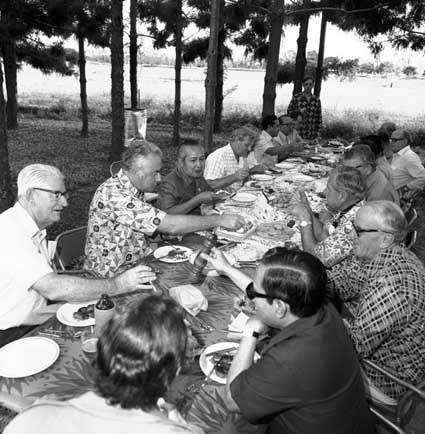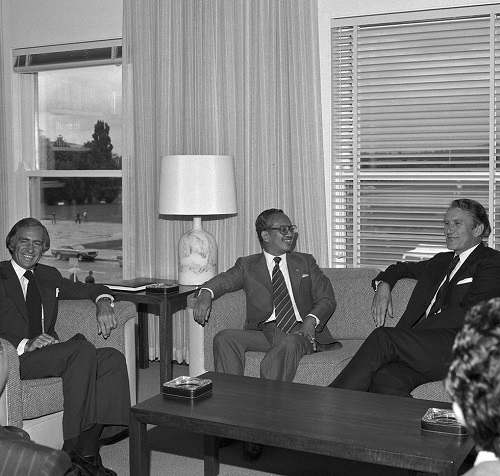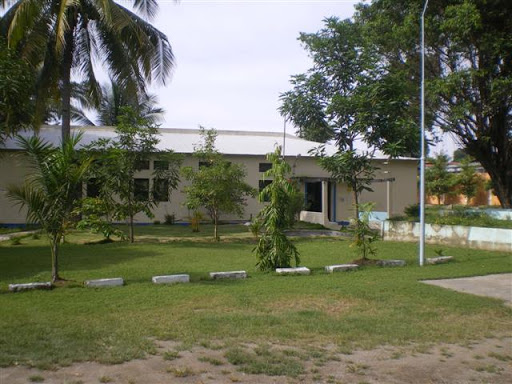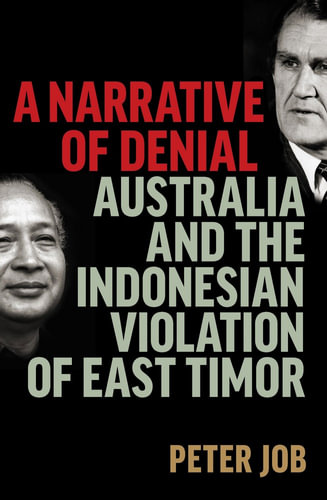Pat Walsh
A Narrative of Denial is an important academic work. It is also an indictment of Australian policy on East Timor during the Fraser years. As such, it is a fitting complement to the Chega! report which includes East Timor’s own assessment of this period. It is to be hoped, however, that it is not ignored in official circles as Chega! has been.
The book’s publisher, Melbourne University Press (MUP), is to be complimented on lending its prestigious name to this work and giving it the status it deserves. Its excellent production is user-friendly and includes an instructive selection of images. These pictures tell the story. Those on the cover show Australian Prime Minister Malcolm Fraser, the Toorak born patrician, looking down on Suharto, the Indonesian dictator, to whose wishes on East Timor Fraser was to defer.
Elsewhere in the book another photo features Gough Whitlam, Fraser’s predecessor as prime minister, who single-handedly laid the foundations of Australia’s disastrous policy on East Timor. In this photo, Whitlam is shown visiting East Timor as a private citizen in 1982. Wearing an Indonesian batik shirt, he is standing in the exercise yard of the political prison where Indonesia detained opponents of its occupation. The image demonstrates Whitlam’s burning determination, post-politics, to prove he was right and his continuing put down of the East Timorese. Ironically, after liberation, this prison became the offices of East Timor’s CAVR (The Timor-Leste Commission for Reception, Truth and Reconciliation) Truth Commission, some of whose commissioners were former political prisoners, and whose report condemned Whitlam for his role. Whitlam, who impugned this reviewer in 1982, also happens to be standing outside the cell that served as my office at CAVR.

A Narrative of Denial is a brilliant exposition of Australia’s policy on East Timor during the Fraser years 1976-1982. Job is to be applauded for his industry. Like a gold digger, he has sifted through tons of material (the book has roughly 1000 references to NAA archives), and processed the evidence he found into a highly readable, unemotional, compelling package. To adapt Hamish McDonald’s accolade in his review of the book, Job has dispelled the fog of denial, burning if off with the bright light of scholarship.
Timor policy during the Fraser years has been addressed before. For one, this reviewer addressed it at the Permanent Peoples Tribunal (PPT) in Lisbon in 1981 and, as mentioned, so does Chega!. What is new and original in this book is (1) that it frames Fraser and places him in the forefront of the long shadow cast by Whitlam, which has shielded Fraser from close scrutiny till now. (2) The book allows Fraser and his officials to speak for themselves. Dressed up as sophisticated diplomacy, their own words demonstrate the cynical disregard for human lives and suffering and bending of the now much touted rule of law that were hallmarks of Australia’s policy.
Of the book’s many extensive quotes, one sums up the fundamental driver of policy in less than ten words. Fraser tells Liberal Senator Neville Bonner, who unlike his boss had been to East Timor: "Nev, they’re just a bunch of commos, forget ‘em". That depiction of Fretilin frames the issue in the absolute Cold War terms of the times. Besides being fallacious, it was the equivalent of a death warrant and justified doing whatever it takes. Where did Fraser get that notion? If not from Bob Santamaria, whose Catholic activist colleagues in Jakarta were key sources of advice and intelligence to both Fraser and Suharto, it would at least have had his imprimatur and encouragement.
Fraser was not a monster. He did good work on ‘captive nations’ like Latvia, on apartheid, Zimbabwe, and PNG and, post-politics, he made a positive contribution to discussion on important issues.

Fraser spared the Timorese his dictum that ‘life was not meant to be easy’ but otherwise contributed to their misery. His decisions on Timor were arguably captive to Cold War ideology and seriously misguided. Thanks in no small measure to his practice of ‘Kissingerian realism’, the Fraser years were East Timor’s worst. The death toll from the war and famine, used as a weapon of war, peaked during Fraser’s watch and both militarily and diplomatically, the Timorese Resistance came very close to being wiped out.
Noteworthy among the book’s other strengths is its highlighting of East Timor’s Chega! report and of the devastating famine of 1977-79. While a welcome addition in many respects, Bernard Collaery’s book Oil Under Troubled Water, 2020 (also published by MUP), for example, makes no mention of East Timor’s own witness and testimony found in Chega! Also welcome is the naming of those MPs from both parties who rejected their bosses’ party line on East Timor during the Whitlam-Fraser years.
While the book focuses heavily on Australia’s Timor policies under Fraser, this reviewer felt it was a tad too generous to Kissinger and Ford whose infamous meeting with Suharto on the eve of the final stage of the invasion sealed East Timor’s fate. The book suggests that the US was not as well informed or engaged with East Timor as Australia and took its lead from Canberra. I find it hard to believe that these top decision-makers, served by a large embassy in Jakarta, State Department and military apparatus, were ignorant, incompetent or relaxed about the breach of US and UN rules that they consented to at that face-to-face meeting with Suharto. The Chega! report, based on primary documents and the testimony of Jose Ramos Horta, Gary Gray (ex-State Department) and the key American activist Arnold Kohen, offers a different analysis.

The book’s strongly worded conclusion is evidence-based, damning and indisputable. Job writes that Australian policy under Fraser was ‘more than a failure of policy goals, it was a failure of conception, morality and ethics, and of fundamental human rights.’
For these reasons, the book should be made widely available, including in translation in Indonesia and Timor-Leste, and used in foreign policy circles as a mirror for self-reflection. The actions of the Fraser government were more than mistakes, honest errors of judgement or sins of omission. By their own admission, leaders made choices between ‘Kissingerian realism’ and ‘Wilsonian idealism’ that had fatal consequences for many innocent East Timorese.
Is no Australian political leader to be held accountable for these decisions, or even to apologise to the Timorese who suffered crimes against humanity and war crimes? Will Australia again engage in a narrative of denial on West Papua or embrace Prabowo Subianto, Suharto’s son-in-law, whose Timor record is frightening, if he succeeds in his bid to replace President Jokowi in 2024?
‘Two roads diverged in a wood’, wrote Robert Frost. As Job suggests, had Australia taken ‘the one less travelled by’, it would have ‘made all the difference’.
Pat Walsh is co-founder of Inside Indonesia. He helped to established to the CAVR in Dili and is now an international adviser to Timor Leste's centre for memory, Centro Nacional Chega!. This version of this review was originally published on his blog.
